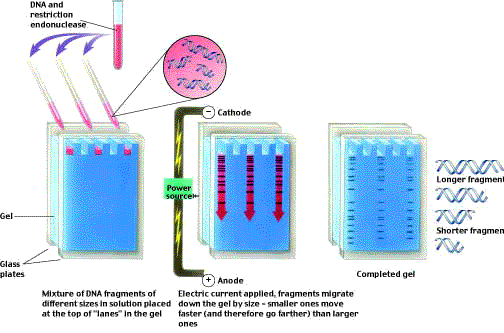2. Genetic engineering involves easily understood procedures. The Four Stages of a Genetic Engineering Experiment
Like the experiment of Cohen and Boyer, most genetic engineering experiments consist of four stages: DNA cleavage, production of recombinant DNA, cloning, and screening.
Stage 1: DNA Cleavage
A restriction endonuclease is used to cleave the source DNA into fragments. Because the endonuclease’s recognition sequence is likely to occur many times within the source DNA, cleavage will produce a large number of different fragments. A different set of fragments will be obtained by employing endonucleases that recognize different sequences. The fragments can be separated from one another according to their size by electrophoresis (figure 4). Stage 2: Production of Recombinant DNA
The fragments of DNA are inserted into plasmids or viral vectors, which have been cleaved with the same restriction endonuclease as the source DNA.
(b)

(a)

Figure 4
Gel electrophoresis. (a) After restriction endonucleases have cleaved the DNA, the fragments are loaded on a gel, and an electric current is applied. The DNA fragments migrate through the gel, with bigger ones moving more slowly. The fragments can be visualized easily, as the migrating bands fluoresce in UV light when stained with ethidium bromide. (b) In the photograph, one band of DNA has been excised from the gel for further analysis and can be seen glowing in the tube the technician holds.